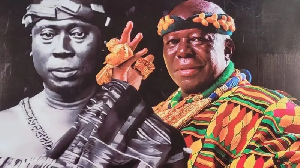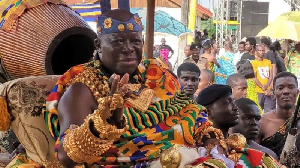
The return of an exiled monarch 100 years ago was celebrated with a boisterous gathering in the field outside the royal palace in Kumasi, Ghana.

Prempeh was the late 19th-century Asante king, often known as the "Asantehene," who resisted British pressure to incorporate his realm into the growing protectorate of the Gold Coast.
In 1896, a British army from the coast marched around 200 kilometers (124 miles) to Kumasi, captured Prempeh along with over 50 of his family members, chiefs, and servants, and then pillaged his palace.
After being transported to the coastal fort at Elmina, the prisoners were sent to Sierra Leone and, in 1900, to the far-off islands of the Seychelles in the Indian Ocean. Prempeh was an elderly man who arrived in Kumasi with a European suit and hat after the British did not permit him to return home until 1924.
In addition to being a terrible tale, it also involves pride and defiance.
The master of ceremonies yelled, "The British did everything they could, but they were unable to break the spirit of Asante." Osei Tutu II, the current Asantehene, was carried through the audience on his palanquin while wearing exquisite gold jewelry. The blare of elephant tusk horns, drum beats, and musket explosions created a tremendous commotion.

Asante culture is alive and well.
Although possibly not in the ways that British officials at the time intended, Prempeh's banishment did have a long-lasting effect on the Asante kingdom and the Seychelles. "It was an honor, though sad, for us to receive your great king," said Seychelles President Wavel Ramkalawan, who was the honored guest during the centennial celebrations held in Kumasi over the weekend.
"He treated our people with dignity and earned the Seychelles' undivided affection," Ramkalawan continued.
The proof of that is in family ties cherished to this day.
Prempeh's great-granddaughter is Princess Mary Prempeh Marimba. After his father left, her grandpa James, the son of Prempeh, first remained on the islands and then married a Seychellois woman. In order to reconnect with numerous long-lost relatives and learn more about her Asante background, Mary, a nurse supervisor in Victoria, the capital of the Seychelles, traveled to Kumasi with her daughter Suzy.
"I come here and celebrate with my family, but there are a lot of mixed emotions, my great-grandfather had a lot of struggles, and this is a sad history," she added. Living in "Ashanti Town," on the former sugar plantation Le Rocher on the main island Mahé, with a view of the ocean and trees of coconut, mango, breadfruit, orange, and jackfruit, were the Asante exiles in the Seychelles.
Dr. Penda Choppy, a Seychellois scholar who also traveled to Kumasi for the centennial celebrations, claims that Prempeh was treated with "every respect and dignity" while residing at the estate's villa. Yaa Asantewaa, a queen who spearheaded the last stand against the British, and about 20 chiefs and attendants were also transferred to the Seychelles after their surrender, which led to the growth of the Asante community in 1901.
Prempeh was altered by the protracted exile. He encouraged the Asante children to go to school after learning to read and write. According to Asante politician and historian Albert Adu Boahen, he became a Christian and "rigidly and uncompromisingly imposed that religion on his fellow political prisoners and their children."
The Asante were not the only exiles in the congregation of the Anglican Church of St. Paul's; they frequently sat with King Kabalega of Bunyoro and King Mwanga of Buganda, both of whom were from present-day Uganda. In fact, the British also sent political prisoners to the Seychelles, often known as a "prison without bars," from Egypt, Palestine, Zanzibar, the Maldives, Malaysia, and Cyprus at different points in time. This was because the British believed that the seclusion of the Seychelles made it the ideal place to house unruly opponents.
The years went by, and Prempeh dreamt of home.
He begged to be permitted to return in a letter to King George V in 1918. Think about how miserable I am because I was captured. How sad it is to observe that after 22 years, the father, mother, brother, and about three-quarters of the chiefs had all passed away. Prempeh writes, "The remaining quarter, some are blind, some are old and tired, and the rest are being attacked by various diseases."
Perhaps sensing that Prempeh's possible death in exile might cause political issues in Asante, the British eventually gave in a few years later. Along with over fifty Asante friends, the most of whom were born in the Seychelles, Prempeh returned to West Africa via ship in November 1924. The Gold Coast Leader, a well-known local daily, stated that those of us who do not know him are eager to see his face.
According to a British official, "the scene presented by the huge assembly…. with their white headbands signifying rejoicing or victory, some laughing and cheering, while others wept with emotion, was a most moving and never-to-be-forgotten sight." Many people in Kumasi slept by the train station to greet him. Although "Mr. Edward Prempeh" was now a private individual in principle, his people regarded him like a king and gave him royal accoutrements, such as the Golden Stool, which is believed to hold the Asante nation's soul.
The role of Asantehene was returned to Prempeh II in 1935 after Prempeh passed away in 1931. Asante scholar and royal museum director Ivor Agyeman-Duah assisted in planning the centennial festivities. They have additional personal significance because Kwame Boatin, his great-grandfather, was among the chiefs who were deported with Prempeh. However, Mr. Agyeman-Duah admits that despite the suffering, exile also offered opportunity to those who endured it.
Because they were able to adjust to the significant changes that Asante, the Gold Coast, and eventually an independent Ghana underwent in the 20th century, Kwame Boatin's children went on to become ambassadors and prominent civil servants. He claimed that the exiles had something to offer because they had been exposed to the outside world. "Their commitment to public service and scholarship continues to inspire us."
I visited Princess Molly Prempeh, a lively woman in her 80s and Prempeh's great-granddaughter, in a community an hour's drive from Kumasi. She informed me, "I am the only person here who was born in the Seychelles." "I'm Ghanaian and Seychellois, and I was five years old when I returned." Molly has made two trips back to the stunning islands where she was born in her latter years. The "Old Creole," which has more French terms she recalls from her early years, delights the Seychellois.
"They yell, 'Hey Princess, how are you?' while I stroll through the streets. "Tu bien, princess, venez, venez?" (Come on in, are you okay?) They are very nice people. In Sesel (Seychelles), they adore the Prempehs. However, there is also a hint of melancholy about Molly's visits. She visits the grave of her mother, Hugette, who brought Molly to the Gold Coast in 1948 when she was a little kid. Later, Hugette went back to the Seychelles, where she passed away. According to legend, she loved to speak the Twi language that Prempeh herself had taught her as a little child, even in her advanced years.
One family’s story of loss, exile and endurance.